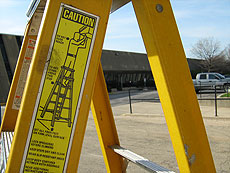Watch out for each other: speak up for safety
 |
| Most of us use ladders from time to time: at our worksites, in the office or at home. Yet few of us stop to review the basic rules for working with ladders. Many of these rules can be found as cautionary warnings right on the ladder. |
If you are walking through the laboratory and see a coworker climbing on the top of a ladder or the step just below it, warning bells should sound in your mind. The person has put him or herself in an unsafe position and could easily fall.
But what should you do about it?
Previous ES&H Tips have discussed the benefits of watching out for each other. But to truly avoid injuries, we must do more than just watch; we must take action. Speak up when you see a coworker engaging in risky behavior. Get involved. Don't let them learn the hard way.
For most of us, noticing an unsafe action and determining that the person needs help comes naturally. But deciding to act, identifying what action to take and following through is more difficult.
In most cases reminding a person to act safer only requires a verbal cautionary statement. Remember, it is in everyone's best interest to avoid mishaps. That may mean approaching another worker about unsafe conditions or behaviors, and your efforts will be appreciated.
Here are some tips for providing feedback:
- State observations rather than interpretations. The former have a more factual and less critical tone than the latter.
- Deliver your message directly and in a nonjudgmental tone.
- Show concern. This can rapidly de-escalate any tension that may arise from the encounter. For example, when approaching or confronting someone who is engaging in a risky behavior, try saying, "I think it's great that you are working so hard, but I just don't want to see you get hurt."
If something more than a cautionary statement is required, ask yourself whether helping will place you at personal risk. No one expects you to injure yourself while assisting a coworker.
-- John Dawson, ES&H
Safety Tip of the Week Archive |